Hurricane Preparedness & Recovery
Community Leaders
Communities look to their leaders for guidance in handling disasters. Before, during, and after disasters, community leaders face the challenge of figuring out how they can best help the different populations they serve when easy communication might not be available.
On this page, we have summarized relevant information from our Disaster Handbook for you. We offer safety tips and guidelines for leading your community back to prosperity.
- Help Your Community Get Ready
- Develop an Emergency Operations Plan
- Find out Information during an Emergency
- Community Concerns Following Impact
- Response Resources
- Other Response Concerns
Help Your Community Get Ready
- Publish a special section in your local newspaper with emergency information on hurricanes.
- Print phone numbers of local emergency services, American Red Cross, and hospitals.
- Provide hurricane tracking charts to local schools.
- Work with local emergency services and American Red Cross officials to prepare special reports for people with mobility impairments on what to do if an evacuation is ordered.
- Stage a simulated evacuation to show your community what can happen—invite the media.
- Host an informational expo at a mall or shopping center. Area media, emergency services, Extension, utilities, and other agencies and organizations can participate.
- Distribute a community newsletter that reviews disaster preparedness and safety issues appropriate to the season or your community’s disaster potential.
- Offer presentations on local emergency issues to civic groups, professional groups, and schools.
Develop an Emergency Operations Plan
- Maximize the efficiency of your community’s response to a disaster.
- Ensure that community leaders know their roles and responsibilities during a major emergency.
- Create support structures between local government, rescue personnel, businesses, schools, hospitals, Extension agents and relief agencies.
- It doesn’t require a major commitment of time and money to put a plan in place.
- Contact your County Emergency Management Office for help in developing a written emergency operations plan.
Find out Information during an Emergency
NOAA Weather Radio is a service of the National Oceanic and Atmospheric Administration (NOAA). During disasters, National Weather Service forecasters can interrupt the routine weather broadcasts to substitute special warning messages.
NOAA Weather Radio broadcasts are made on one of seven highband FM frequencies not found on the average home radio. However, a number of radio manufacturers offer special weather radios with these frequencies. Also, there are now many radios on the market which offer standard AM/FM frequencies plus the "weather band" as an added feature.
For more information, see the UF/IFAS Disaster Handbook.
Community Concerns Following Impact
- Rescue of injured or endangered residents, removal of victims, evacuation
- Downed electric wires, power outages
- Leaking gas mains, ruptured chemical containers
- Containing and extinguishing fires
- Prevention of looting
Response Resources
Beyond local government and emergency services such as police and fire departments, communities can look for assistance from the following resources:
- The American Red Cross. Providing food and shelter to disaster survivors is a major goal of Red Cross assistance, but assistance can also extend to back-up medical services, especially in smaller communities.
- The state highway department may be called in for rerouting of traffic and related concerns.
- The National Guard may be called in to prevent looting, help with sandbagging in a flood, or any number of other measures involving manpower.
Other Response Concerns
- Is the water safe to drink?
Testing for safe water should begin and continue throughout disaster recovery because of the chance of contamination from many different sources. - Sewers.
Chemical spillage needs immediate attention to prevent problems at sewage treatment plants that may be overloaded with floodwaters. - Structural safety. Are buildings and homes safe to enter? Professional building inspection is critical.
- Hazardous materials.
All hazardous materials stored at commercial and other properties should be accounted for, from industrial chemicals to those used at dry cleaning stores and gas stations. Spills can be a problem, and pressurized tanks could burst. Fire departments are required to keep an inventory of hazardous material locations. - Damaged trees, debris.
Debris is a major cause of injury during clean-up. Machinery should be brought in to help clear and dispose of wreckage.
Excerpted and adapted from:
The Disaster Handbook, UF/IFAS Extension (rev. 11/03).

Related Sites & Articles
- UF/IFAS Publications
- Assessing Damage and Restoring Trees After a Hurricane
- Disaster Handbook
- Disaster Preparedness and Recovery Publications
- Florida Homeowners Handbook to Prepare for Natural Hazards (pdf)
- Safe Handling of Food and Water in a Hurricane or Related Disaster
- Wind Damage Mitigation
- UF/IFAS Sites
- Trees and Hurricanes
- Agencies & Organizations
- Federal Emergency Management Agency (FEMA)
- Federal Alliance for Safe Homes (FLASH)
- Hurricanes--FEMA
- MySafeFlorida.org
- National Hurricane Center--NOAA
- U.S. Department of Homeland Security

